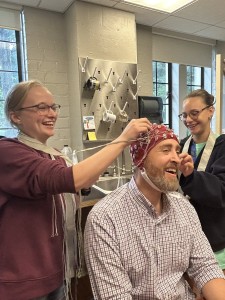“Have you ever wondered what is going on inside your head?!”
This enticing question, posed in an email, drew over 40 Kenyon students to participate in a recent study about memory and how emotions like anxiety can influence them.
This summer, the gentle hum of sophisticated machinery filled the air in the neuroimaging lab, and the radiant smiles of Blythe Karras ’25 and Hollen Knoell ’25 lit up the room. Both psychology majors were Summer Science Scholars — Knoell also is pursuing a major in ancient Greek — who were mentored by Associate Professor of Psychology Andrew Engell.
For many rising seniors, the last summer on the Hill is a bittersweet farewell, but Karras and Knoell were excited to plunge into the thrilling world of neuroscience research.
Their summer research utilized electroencephalography (EEG), a test to measure the brain’s electrical activity. Karras and Knoell investigated the relationship between theta brain waves (associated with anxiety levels and memory formation) and episodic memory (a type of memory that stores personal events with contextual details). This research has the potential to unravel the complexities of memory formation and recall, offering insights into how we remember our experiences and how emotions can influence them.
To conduct the EEG study, Karras and Knoell recruited fellow college students with the promise of monetary rewards and a personalized copy of their brain waves. Each participant wore a gel-filled cap with tiny holes connected to several electrodes. (Rest assured, the gel was easy to wash out.)
They were then led into a small booth affectionately named “Veronica.” Once inside, they were shown people’s faces on a computer screen to rate as “dominant” or “trustworthy.” After a 10-minute break was given and participants were allowed to use their phones, they took another test to assess if they could remember the faces they had been shown earlier.
All of this happened while the participants were still capped. “We test memory while participants are still in the cap, unlike previous studies that separate encoding and retrieval,” Knoell explained. This allowed the pair to observe the participant’s theta brainwave activity when the brain encodes the face and then tries to remember it.
While the process — which took about an hour and a half — was not physically demanding, it could be anxiety-inducing; however, the experiment aimed to study how pre-existing anxiety impacts memory performance rather than inducing anxiety itself. The data was meticulously analyzed using computer software.
This research was noteworthy for Kenyon students because it could shed light on how emotional states possibly influence academic performance. For students striving to excel academically, understanding this connection could provide valuable insights into managing stress and enhancing their performance.
“This research has changed my life!” Blythe said.
Indeed, the summer research was nothing short of transformative for the duo, as it was a very hands-on experience. What started as a curiosity in neuroscience and EEG study turned them into seasoned neuroscientists.
“I have two exceptional students who have made it easy and fun this summer!” Engell said, appreciating their dedication and impact on the research.
This article was written by Samantha Ofori ’26 as part of the Hoskins Frame Summer Science Writing Scholars program.
